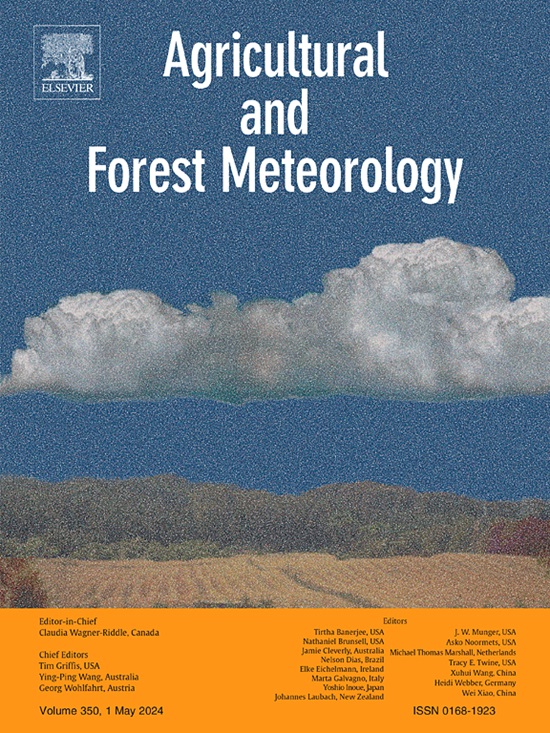Global distribution of leaf maximum carboxylation rate derived from the TROPOMI solar-induced chlorophyll fluorescence data
IF 5.6
1区 农林科学
Q1 AGRONOMY
引用次数: 0
Abstract
Photosynthesis plays an important role in the terrestrial carbon cycle and is often studied using terrestrial biosphere models (TBMs). The maximum carboxylation rate at 25 °C (Vcmax25) is a key parameter in TBMs, and yet the information on the spatiotemporal distribution of this parameter is uncertain. In this study, we retrieved the global distribution of Vcmax25 at 0.25° resolution based on TROPOMI-observed solar-induced chlorophyll fluorescence (SIF) and meteorological forcing data using a parameter optimization technique. This study improves global mapping of Vcmax25 using TROPOMI's SIF and MODIS photochemical reflectance index (PRI) for accurate GPP estimation by sunlit leaves in the following aspects: the previous method relied on an empirical estimation of the ratio of SIF per unit sunlit leaf area to that per unit shaded leaf area (β), while β here was derived from a look-up table (LUT) constructed using the Soil-Canopy Observation of Photosynthesis and Energy (SCOPE) model. Validated at two flux tower sites, the LUT method explained most of the variation in β with R2 = 0.71 and 0.67, RMSE=0.19 and 0.15 and Slope=0.84 and 0.70 for two ground validation sites. We calculated the global ratio of SIF from sunlit to that from shaded leaves (SIF_ratio), and found that the had a strong spatio-temporal variability with a global average of approximately 4.6, and that the contribution of SIF from shaded leaves to the canopy total was <20 %. The optimized Vcmax25 from TROPOMI was validated against Vcmax25 derived from concurrent flux data at 27 sites distributed globally using an independent method (R2 = 0.39 - 0.65, RMSE = 6.47 - 21.74 μmol m-2 s-1 and rRMSE =0.14–0.36). Based on the improved global Vcmax25 map, we found that, spatially, Vcmax25 varies significantly with latitude and between- and within-plant function types (PFTs), and temporally, it has strong seasonal variation in all PFTs except evergreen broadleaf forests. The new global Vcmax25 dataset would be useful for improving terrestrial GPP modelling from the current state of the art of using constant Vcmax25 values by plant functional type.
求助全文
约1分钟内获得全文
求助全文
来源期刊
CiteScore
10.30
自引率
9.70%
发文量
415
审稿时长
69 days
期刊介绍:
Agricultural and Forest Meteorology is an international journal for the publication of original articles and reviews on the inter-relationship between meteorology, agriculture, forestry, and natural ecosystems. Emphasis is on basic and applied scientific research relevant to practical problems in the field of plant and soil sciences, ecology and biogeochemistry as affected by weather as well as climate variability and change. Theoretical models should be tested against experimental data. Articles must appeal to an international audience. Special issues devoted to single topics are also published.
Typical topics include canopy micrometeorology (e.g. canopy radiation transfer, turbulence near the ground, evapotranspiration, energy balance, fluxes of trace gases), micrometeorological instrumentation (e.g., sensors for trace gases, flux measurement instruments, radiation measurement techniques), aerobiology (e.g. the dispersion of pollen, spores, insects and pesticides), biometeorology (e.g. the effect of weather and climate on plant distribution, crop yield, water-use efficiency, and plant phenology), forest-fire/weather interactions, and feedbacks from vegetation to weather and the climate system.

 求助内容:
求助内容: 应助结果提醒方式:
应助结果提醒方式:


